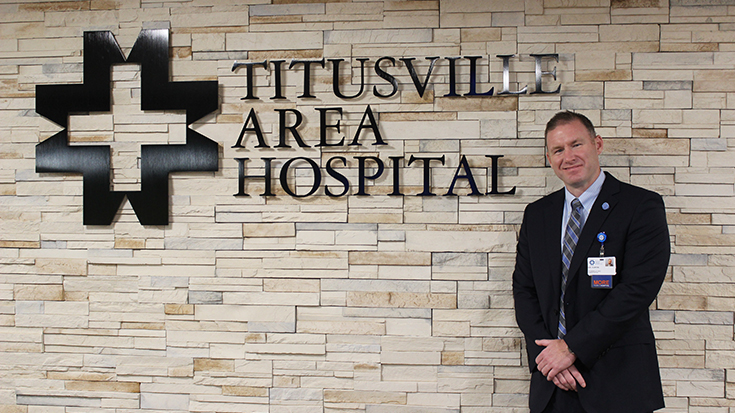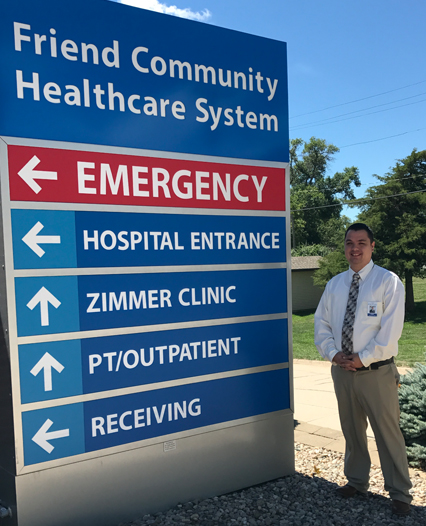
As a respiratory therapist, you know you have lots of career options. But just how far can you go in terms of career advancement? Two therapists who began their careers just like the rest of us (as bedside clinicians) explain how they ended up as CEOs of their critical access hospitals.
When, why, and where did you become a respiratory therapist?

Chad Thompson: I obtained my bachelor of science with a concentration in respiratory therapy from Midland Lutheran College in June 2004. I originally was a nursing major, but after three years, I decided that nursing really wasn’t what I wanted to do. During my clinical rounds, I was able to experience what respiratory therapists do first hand. I found that their work really interested me, so I changed my major and the rest is history.
Lee Clinton: I received my bachelor’s degree in respiratory therapy from the University of Missouri in 2001. I was introduced to respiratory therapy as a profession by a friend in college who had cystic fibrosis and relied on the care and treatment from RTs.
What are some of the career building steps you took to work your way up the ladder and why do you think they were important to your advancement?
Chad Thompson: I wanted to gain experience in a “bigger facility” when I completed school. I worked at a 500-bed hospital for just over a year. I am from a small town, so my goal was to eventually work as a respiratory therapist in a critical access hospital setting and I was fortunate enough to actually start respiratory therapy departments for three critical access hospitals. Each position that I took always had more responsibility than the last, and I never turned down any additional projects. I think by starting those departments, and taking on additional projects, it really prepared me for the role that I am in today.
Lee Clinton: Following graduation from RT school I worked full-time on the night shift while I pursued a master’s degree in healthcare administration, also from the University of Missouri, and later an MBA. Like most leaders with a clinical background I got my first supervisory opportunity overseeing a respiratory therapy department at a HealthSouth inpatient rehab hospital. I was fortunate to have the opportunity to grow and supervise some additional ancillary departments after a short period of time.
With that multi-departmental supervisory experience, a clinical background, and the knowledge of regulatory and accrediting bodies I learned at HealthSouth, I then took a position as the COO of a critical access hospital in Southeast Missouri. I spent ten years in that position before accepting my current role as the CEO of a critical access hospital in Northwest Pennsylvania.
What led to your interest in acquiring the top job in the hospital where you are now and what does that job entail?
Chad Thompson: I am currently the president and CEO of Friend Community Healthcare System. I oversee a 19-bed critical access hospital and eight room physician clinic. We have a total of 50 employees. Working in the critical access world, I have seen the struggles that many of the hospitals face. I knew that I could make a positive impact, and this is what drove me to further my education to the master’s degree level.
Lee Clinton: After spending ten years in the number two seat as COO, I felt I was ready and well prepared for a CEO position, and I’ve been fortunate to have some great mentors and colleagues over the years. In my current role, I serve as the site chief executive of the system-owned critical access hospital and system VP, reporting to the CEO of the parent organization. As the CEO I am responsible for the overall efficient functioning and coordination of all hospital departments, strategic planning, program development, organization of departments, control of activities, and interpreting and administering policies of the Governing Board, as well as ultimately responsible for all financial and program performance. I directly manage the organization VPs and select department directors and interface with system hospital leaders on a daily basis.
How is your background as a respiratory therapist helping you in your role in upper management?
Chad Thompson: It has helped me in more ways than I could have imagined. The patient care aspect has really allowed me to see situations from the patient’s perspective, which is something that is sometimes lacking in administration. It has also helped me from the perspective of the employee point of view. Having worked in critical access hospitals for almost 10 years, I was able to see the struggles that nurses, providers, and ancillary departments go through on a daily basis. This allows me to think strategically on the different effects on the hospital financially when making decisions.
Lee Clinton: I believe that having a clinical background is a very positive attribute of a leader in a health care organization and I believe it lends credibility that “the guy in the suit,” as executives are sometimes called, doesn’t only understand or care about the numbers. It provides firsthand knowledge of the dynamics of the clinical team as well as simple things like medical terminology.
You’ve maintained your membership in the AARC. Why is it important to you to continue to belong to the association that represents your initial role in health care?
Chad Thompson: The AARC brings many valuable tools to respiratory therapists. I have always thought that being a member of the association of your profession is something that you should always do, especially for the unlimited resources available. The AARC has always been extremely helpful throughout my career as a respiratory therapist. I still practice respiratory therapy today, despite being a CEO, so I have made sure to keep my AARC membership active and will continue to do so throughout my career.
Lee Clinton: I’ll always have an affinity for respiratory care and would like to see the profession grow and succeed. I believe the AARC is the vehicle to make that happen on a national level and therefore believe supporting it is worthwhile.
What advice do you have for other therapists who see themselves climbing the ladder to the top one day?
Chad Thompson: Remain positive no matter what happens. You will have obstacles in your way, but they just make you stronger in the end. Always be a team player and never turn down more responsibility.
Lee Clinton: Have a plan for what you want from your career. To rise in the ranks of health care leadership it takes sacrifice, personal accountability, and the ability to hold others accountable in a way that builds them up versus tearing them down. I think it looks easier from the outside looking in, but the reality is, not everyone is cut out to be a good leader. If you are, find a good mentor to help give you feedback about yourself and be someone you can confide in. Don’t choose a mentor because you think they can give you a job — it’s much deeper than that.
Finally, experience is very meaningful. Gain as much experience as you can in topics that lead you toward your goal of advancement. Volunteer to get on committees and do some heavy lifting. Early in your career it’s about gaining experience that you can draw upon and highlight to allow yourself to be considered for advancement.





